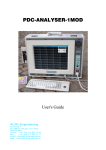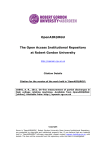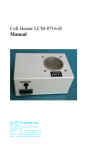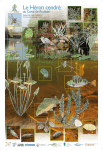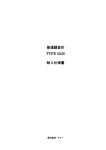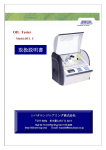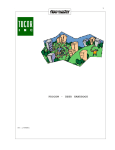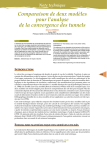Download PDC-ANALAYSER user's guide
Transcript
Conductivity Meter For Liquids LCM-8716 Manual ALFF Engineering Gomweg 7 CH 8915 Hausen am Albis Switzerland phone: +41 44 77 66 77 6 fax: +41 44 77 66 77 7 email: [email protected] web: www.alff-engineering.ch ALFF Engineering Content 1 Introduction ......................................................................................................................................................................3 2 Measuring method........................................................................................................................................................3 3 Conformity and compatibility of standards...................................................................................................4 4 Measuring instrument ................................................................................................................................................4 5 Test cell ..............................................................................................................................................................................4 6 LCM-calculator..............................................................................................................................................................5 7 Performing a measurement .....................................................................................................................................8 8 A typical application ...................................................................................................................................................8 9 References .........................................................................................................................................................................9 10 Specifications .............................................................................................................................................................10 Appendix A: Cleaning procedures of the test cell .......................................................................................11 Appendix B: Part list of LCM-8716 ....................................................................................................................12 Copyright ALFF Engineering / Switzerland 2 ALFF Engineering 1 Introduction The Conductivity Meter For liquids LCM-8716 conforms to the new IEC 61620 standard [1]. This instrument is based on the so-called "low amplitude, low frequency, alternate square wave method" and permits accurate measurement of volume conductivity and relative permittivity over a wide range without disturbing the thermodynamic equilibrium of the liquids investigated [2, 3, 4, 5]. The measurement of volume conductivity in the range of 0.01 pS/m to 20'000 pS/m allows the use of this instrument for quality assessment of high resistive liquids even at ambient temperature. 2 Measuring method The liquid in the test cell is excited with a low amplitude (30 V) low frequency (0.5 Hz) alternate square wave voltage without any dc component (see figure 1). By measuring the current through the liquid the capacitance C and the conductance G can be determined and the values of relative permittivity εr and volume conductivity σ are given according to the following equations: εr = C/Co [1] σ = εo.G/Co [2] where εo is the permittivity of vacuum equal to 8.8541×10-12 As/Vm and Co is the vacuum capacitance. The derived dissipation factor tanδ for a given frequency f can be determined according to the following equation: tan δ = G C ⋅ 2πf [3] For insulating liquids used in electrical power apparatus, the conduction is the sole cause of loss at power frequencies (50/60 Hz), which are low frequencies indeed. Therefore, the dissipation factor tanδ calculated from the measured εr and σ with alternate square wave method is equal to the value of tanδ measured with the classic bridge method [5, 6]. For determination of conductivity or tan-delta, the alternate square wave method is, by far, more sensitive than the classic bridge method. It permits the determination of conductivity values down to 0.01 pS/m respectively tanδ values down to 1E-6 (at 50 Hz). This high sensitivity allows accurate measurements of conductivity and tanδ at low temperatures and consequently the characterisation of liquids at room temperature can be carried out with confidence [5, 6]. +V Applied voltage u(t) Time -V TF Generated current i(t) IC=C V/TF C=εoεr Co IR=V/R=GV Time G=(σ/εo) Co Co: Vacuum capacitance Principle of operation using the alternate square wave method Figure 1: Measuring method used in LCM-8716 Copyright ALFF Engineering / Switzerland 3 ALFF Engineering 3 Conformity and compatibility of standards The LCM-8716 instrument is developed according the new IEC 61620 standard [1]. This new standard doesn't substitute the old IEC 60247 standard (old nomination IEC 247) [7], but it is a complement to it. The IEC 61620 standard proposes a new measurement method, the so called "low amplitude, low frequency, alternate square wave method", permitting an accurate determination of the conductivity, relative permittivity and dissipation factor (tanδ) of highly insulating liquids at low temperature without disturbing their thermodynamic equilibrium. It is well known that the conductivity is a characteristic of a liquid only if it is measured at thermodynamic equilibrium. The investigations of Task Force 04 of Cigré WG 15.02 [5, 6] have demonstrated that the application of high electric stress and/or prolonged voltage application as specified in the old IEC 60247 standard can disturb the thermodynamic equilibrium of highly insulating liquids and generate unrepresentative results of conductivity and tanδ. The specification of IEC 60247 are only acceptable for tanδ measurements of moderately insulating liquids. This was the main trigger to work out the new IEC 61620 standard as complement to IEC 60247 standard describing an adequate measuring method for investigations on highly insulating liquids. 4 Measuring instrument This instrument works with low voltage and low current levels and represents no danger at all for its operators. To avoid possible damage, do not short circuit the electrodes of test cell when these are connected to instrument and the instrument is turned on. The specification of this measuring instrument is given in section 9. 5 Test cell The application of a square wave excitation voltage with low amplitude of only ±30 V permits the development of a test cell with simple design, easy to use and to clean. The compact test cell of the LCM-8716 is composed of only two parts, a container and an active part. Two coaxial electrodes (stainless steel) are attached on a cap (also stainless steel). This cap also supports two BNC connectors coupled to the two electrodes. The electrodes possess a clean, polished surface. The vessel and the active part can be cleaned according to procedures described in the appendix A. It is not possible and not necessary to disassemble the active part for cleaning purposes. The required amount of liquid for a standard test cell LCM-8716-CS is about 210 ml. To reach this amount, fill in the liquid to be tested up to 23 mm from the top edge of the vessel The temperature of the tested liquid can be determined by introducing the electronic thermometer in the cell through the cover orifice. When using a metallic thermometer on the 20 pS/m scale, the thermometer should be grounded with the grounding clip coming with the instrument to avoid introducing electrostatic noise into the cell. The specification of this cell is given in section 9. Copyright ALFF Engineering / Switzerland 4 ALFF Engineering 6 LCM-calculator The LCM-8716 equipment itself permits the measurement of the volume conductivity σ and the relative permittivity εr at a temperature T. Such a data set of the dielectric properties can be transformed mathematically into various other variables: • Resistivity: the inverse of the conductivity • Tanδ: the ratio of the in-phase current (resistive current) and the capacitive displacement current at a given frequency • Power factor: the cosine of the phase angle between alternating field strength and current density at a given frequency • Discharge time constant: decay time constant of a volume charge density • Volumetric heating: heating density at a given electric field strength Although these transformations could be done on a pocket calculator, ALFF ENGINEERING offers a software “LCM-calculator” which can be downloaded as freeware at www.alff-engineering.ch/PDF/LCM3.zip and www.alff-engineering.ch/downloads.htm This “LCM-calculator” permits also to extrapolate all these variables to other temperatures. Depending on the temperature gap and on the accuracy of the temperature dependancy coefficients for the extrapolation, the uncertainty caused by the extrapolation could be very low to extremely large. This extrapolation feature must be used with care and professionalism. Figure 2: Screen shot of the main window of the LCM-calculator. Copyright ALFF Engineering / Switzerland 5 ALFF Engineering For most insulating liquids, the temperature dependency of volume conductivity can be described with an exponential law according to the equation: σT1 = σT2 exp{(-Ec/k) [(1/T2)-(1/T1)]}, [6] where σT1 and σT2 are the values of volume conductivity at temperatures T1 and T2 expressed in Kelvin [K]. Ec is the activation energy in [eV] and k is the Boltzmann constant equal to 8.62×10-5 [eV/K]. For most of presently available dielectric liquids, the variation of relative permittivity in dependency of temperature around 20°C is mainly due to the variation of their volume in function of temperature. This variation can be described with the linear equation: εrTm = εr20 [1+νcp (Tm-20)], [7] where εrTm and εr20 are respectively the values of relative permittivity measured at temperatures Tm [°C] and 20°. νcp is the variation coefficient of permittivity at 20°C expressed in [1/°C]. If the parameters Ec and νcp and their validity ranges are known for a liquid, it is possible to perform temperature conversions of all above mentioned quantities with high accuracy. It is recommended to customize the LCM-calculator according your needs by clicking on Figure 3: Screen shot of the Setup window of the LCM-calculator. Copyright ALFF Engineering / Switzerland 6 : ALFF Engineering The LCM-calculator accepts freely set values for Ec and νcp. All the same, specific values of Ec and νcp for new and used mineral oil have been implemented according to references [8, 9] to make simpler a first assessment. Using preset values for Ec and νcp is astonishing precise for small extrapolations as measuring at 22.9 °C and extrapolating to 25 °C. However, making extrapolations without precise knowledge about Ec for large temperature differences like measuring at 15 °C and extrapolating to the “would be properties” at 90 °C results in a high uncertainty because the uncertainty increases more rapidly than proportional to the temperature bridged. There are three alternatives for setting up the activation energy and the permittivity variation coefficient: • By making use of two measurement results of the insulating liquid done at temperatures well apart. Enter these values in the Setup window and the LCM-calculator computes both Ec and νcp. This is the recommended method for more pronounced interpolations and extrapolations and yields good results. • By entering manually the figures for the activation energy and the permittivity variation coefficient known by you from previous measurements of this insulating liquid or known from measurements of almost identical samples. • If these coefficients are completely unknown, the typical values proposed in the setup window can be used. These values should be considered guess values and they are useful for modest extrapolations only. On the setup window, you can also choose the “properties of interest”. ALFF ENGINEERING recommends to check only the properties significant to the actual investigation to keep affairs simple and uncrowded The frequency in the setup window is required exclusively for tanδ and power factor computation as these properties change with frequency. Similarly, the field strength is required exclusively for the volumetric heating computation. Use F1 to evoke help and to find computation details like the formulas used. Copyright ALFF Engineering / Switzerland 7 ALFF Engineering 7 Performing a measurement Clean the test cell according IEC61620 [1] (see also Appendix A). Before filling in any liquid to be tested, connect the test cell to the measuring device by means of the two BNC cables. As the test cell now contains air, the relative permittivity is 1.000 and the conductivity is too low to be seen by this device. Turn on the instrument and choose the range of relative permittivity to < 2. So, the relative permittivity can now be calibrated to 1.000 by making use of the adjustment knob located under the permittivity display. The conductivity display is supposed to show 0 on all ranges. Calibrating the relative permittivity means calibrating also the conductivity measurement as this adjustment influences both displays by the same factor. Turn off the instrument, remove the BNC cables from the test cell plugs and open the test cell. Fill in the liquid to be tested up to 23 mm from the top edge of the stainless steel vessel, or fill in about 210 ml of liquid. Connect the BNC cables, turn on the instrument and insert the thermometer, if necessary switch the relative permittivity range to εr ≥ 2 and find the appropriate range for the conductivity. 8 A typical application A typical application of LCM-8716 is the quality assessment of mineral oil used in high voltage apparatus e.g. power and instrument transformers, bushings, capacitors, etc. Several investigations have demonstrated that the conductivity of oil is influenced by impurities and ionic components, which are introduced or produced in it [8, 9]. Therefore, the oil conductivity characterises well the quality of oil. Further, it has been shown that the moisture in oil has no significant influence on its conductivity [10]. The following values of conductivity given at ambient temperature are typical for a mineral oil in its different states of use. - "New" unused oil (laboratory quality) "New" unused oil (industrial quality) Light used oil in good condition Middle used oil in acceptable condition Heavily used oil in bad condition Copyright ALFF Engineering / Switzerland ≤ 0.05 0.05…0.1 0.1…1.0 1.0…5.0 > 5.0 8 pS/m pS/m pS/m pS/m pS/m ALFF Engineering 9 References 1 IEC Publication 61620, Insulating liquids – Determination of the dielectric dissipation factor by measurement of conductance and capacitance – Test method, 1998. 2 Hilaire, M., C. Marteau, R. Tobazéon: Apparatus Developed for Measurement of the Resistivity of Highly Insulating Liquids, IEEE Transactions on Electrical Insulation, Vol. 23 No. 4, August 1988, pp. 779-787. 3 Tobazéon, R., J. C. Filippini, C. Marteau: On the Measurement of the Conductivity of Highly Insulating Liquids, IEEE Transactions on Dielectrics and Electrical Insulation, Vol. 1 No. 6, December 1994, pp. 1000-1004. 4 Li, Y., J. Rungis: The square wave voltage method for the measurement of low level tanδ of liquid dielectrics, 1997 IEEE International Conference on Properties and Applications of Dielectric Materials, IEEE Publication 97CH35794, pp. 1125-1128. 5 Berger, N., J. C. Filippini, R. Tobazéon: Progress in the determination of the dissipation factor tanδ and /or the resistivity ρ of dielectric Liquids, Cigré Journal ELECTRA No. 185, August 1999. 6 GIGRE Report on 15-02 Working Group activities on Dielectric Liquids, Paris 31 August 1994 7 IEC Publication 60247, Measurement of relative permittivity, dielectric dissipation factor and d.c. resistivity of insulating liquids, 1978. 8 Diabi, R., J. C. Filippini, C. Marteau, R. Tobazéon: On the role of temperature and impurities in the low field conduction of insulating liquids, Conference Record of ICDL'96 12th International Conference on Conduction and Breakdown in Dielectric Liquids, Rome 1996, IEEE Publication 96CH35981, pp. 350-353. 9 Bartnikas, R.: Electrical Insulating Liquids, ENGINEERING DIELECTRICS VOLUME III, ASTM Publication Code Number (PCN) 31-002093-21, ISBN 0-8031-2055-9, 1994. 10 Itahashi, S., H. Mitsui, T. Sato, M. Sone: State of Water in Hydrocarbon Liquids and its Effect on Conductivity, IEEE Transaction on Dielectrics and Electrical Insulation, Vol. 2, No. 6, December 1995, pp. 1117-1122. 11 IEC Publication 60296, Specification for unused mineral insulating oils for transformers and switchgear, 1982. 12 IEC Publication 60963, Specifications for unused polybutenes, 1988. 13 IEC Publication 60867,Insulating liquids – Specifications for unused liquids based on synthetic aromatic hydrocarbons, 1993. 14 IEC Publication 61099, Specification for unused synthetic organic esters for electrical purposes, 1992. 15 IEC Publication 60836, Specification for silicon liquids for electrical purposes, 1988. Copyright ALFF Engineering / Switzerland 9 ALFF Engineering 10 Specifications Conductivity Meter For Liquids LCM-8716 Electronic measuring instrument conductivity measurement range resolution of the conductivity measurements uncertainty of conductivity measurements relative permittivity measurement range resolution of permittivity measurements uncertainty of permittivity measurements calibration of the test cell frequency of the measurement voltage amplitude of the measurement voltage optional analogue outputs analogue output voltage span weight size power supply in the field power supply in the lab temperature (use) temperature (stock) pressure humidity acceleration 10-14 ... 2×10-8 S/m on four ranges 10-14 S/m for conductivity up to 19.99 pS/m -13 10 S/m for conductivity up to 199.9 pS/m 10-12 S/m for conductivity up to 1.999 nS/m -11 10 S/m for conductivity up to 19.99 nS/m ±1 digit ±1% of indicated value up to 5.00 0.001 for relative permittivity up to 1.999 0.01 for relative permittivity from 2.00 to 5.00 ±1 digit ±0.2% of indicated value simple on-site adjustment for test cells from 50 to 70 pF 0.5 Hz ±30 V square wave with no dc part one for conductivity, one for relative permittivity 0 ... 2 V for 0 to 100% of chosen range, short circuit proof 2.6 kg 260 × 283 × 115 (width × depth × height in mm) six batteries type AA alkaline for several hours of operation universal mains adapter 100 ... 240 Vac 50/60 Hz delivering 6 V DC 0…35°C -10…50°C 70…106 kPa 5…80 % non condensing <2g Test cell required amount of liquid vacuum capacitance capacitance drift with temperature electrode gap material electrical connection temperature measurement weight size cables Copyright ALFF Engineering / Switzerland 210 ml ≈ 60 pF < 50 ppm/°C 1.5 mm stainless steel two standard 50 Ω BNC plugs glass thermometer or electronic thermometer 1.2 kg 125 × 82 (height × diameter in mm) one BNC-BNC cable, 1m, red, for application of the excitation one BNC-BNC cable, 1m, black, ultra low noise for current measurement 10 ALFF Engineering Appendix A: Cleaning procedures of the test cell Two cleaning procedures have been proposed in the IEC 61620 Standard [1], an exhaustive and a simplified procedure. I) Exhaustive cleaning procedure for the test cells a) Empty the cell and drain off the liquid from electrodes and vessel. b) Boil the complete cell for at least 5 min. in a solution of about 5% trisodium phosphate diluted in deionised water. Afterward rinse the cell several time with de-ionised water. c) Rinse for 5 min. under running tap water. d) Boil the complete cell in de-ionised water for minimum half an hour. e) Dry the cell in a clean oven at 105°C for 2 hours. f) Let the cell cool down to ambient temperature in a desiccator without touching the surface of electrodes with bare hands. g) Fill the cell with the insulating liquid to be measured. h) Empty the first filling and perform the measurement on the second filling. If the cleaned cell is not used immediately, store it in a desiccator avoiding any contamination. II) Simplified cleaning procedure for test cells used for only one type of liquids The following procedure can be applied to clean cells, which are devoted to only one type of liquid: a) Empty the cell and drain off the liquid from electrodes and vessel. b) Rinse for 5 min. the electrodes and the vessel of the cell with an analytical grade solvent appropriate to the previously tested liquid*. c) Rinse the different parts with analytical grade ethanol. d) Dry the cell in a clean oven at 80°C for 3 hours and let the cell cool down to ambient temperature in a desiccator. e) Fill the cell with the insulating liquid to be measured. f) Empty the first filling and perform the measurement on the second filling. *) Recommended analytical grade solvents: Cyclohexane for - hydrocarbon liquids like mineral oil (IEC 60296) [11]; - polybutenes (IEC 60963) [12]; - alkylbenzene, mono/dibenzyltoluene, phenylxylylethane and isopropylnaphthalene (IEC 60867) [13]; Ethanol for - organic esters like dioctylphthalate, tetrahydricalcohol esters (IEC 61099) [14]; Toluene for - silicone liquids (IEC 60836) [15]. Copyright ALFF Engineering / Switzerland 11 ALFF Engineering Appendix B: Part list of LCM-8716 1 piece measuring device 1 piece test cell stainless steel electrodes 1 piece test cell stainless steel vessel 1 piece test cell electronic thermometer with adapter 1 piece black BNC-BNC low-noise cable "measurement" 1 piece red BNC-BNC cable "test signal" 1 piece power supply delivering 6 V DC from 100 Veff to 240 Veff 50/60 Hz, EURO-plug 6 pieces primary cells type "AA alkali manganese" for about 15 hours of operation 1 piece CDROM "LCM-calculator" for PC’s with Windows 95/98/ME/2000/XP 1 piece clip for grounding metallic thermometers 1 piece this manual Copyright ALFF Engineering / Switzerland 12












